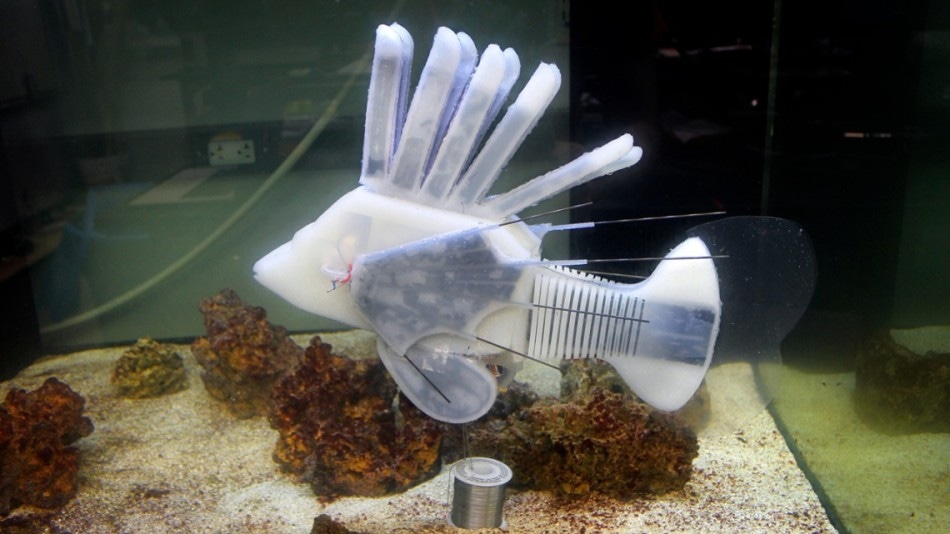Jun 21 2019
Untethered robots have to deal with a stamina issue. A probable solution could be a circulating liquid — “robot blood” — that can store energy and drive its applications for high-tech, long-duration operations.
 An aquatic soft robot, inspired by a lionfish and designed by James Pikul, former postdoctoral researcher in the lab of Rob Shepherd, assistant professor of mechanical and aerospace engineering. (Image credit: Cornell University)
An aquatic soft robot, inspired by a lionfish and designed by James Pikul, former postdoctoral researcher in the lab of Rob Shepherd, assistant professor of mechanical and aerospace engineering. (Image credit: Cornell University)
Man and other complex organisms cope with life through integrated systems. Man stores energy in fat reserves spread throughout the body, and an elaborate circulatory system carries oxygen and nutrients to drive trillions of cells.
But when the hood of an untethered robot is opened, things are a lot more segmented: There is a solid battery in one corner and the motors in another, with cooling systems and other parts spread throughout.
Cornell scientists have developed a synthetic vascular system that can pump an energy-dense hydraulic liquid that stores energy, conveys force, works appendages, and gives structure, all in a unified design.
In nature, we see how long organisms can operate while doing sophisticated tasks. Robots can’t perform similar feats for very long. Our bio-inspired approach can dramatically increase the system’s energy density while allowing soft robots to remain mobile for far longer.
Rob Shepherd, Associate Professor of Mechanical and Aerospace Engineering, Cornell University
Shepherd, director of the Organic Robotics Lab, is senior author of the research paper “Electrolytic Vascular Systems for Energy Dense Robots,” which was published on June 19th in Nature. Doctoral student Cameron Aubin is the paper’s lead author.
Engineers depend on lithium-ion batteries for their dense energy-storage property. But solid batteries are bulky and cause design limitations. On the other hand, redox flow batteries (RFB) depend on a solid anode and very soluble catholyte to work. The dissolved components store energy up to it is discharged in a chemical reduction and oxidation (redox) reaction.
Soft robots are typically fluid — up to about 90% fluid by volume, and in several cases use hydraulic liquid. Using that fluid to store energy offers the option of better energy density without increasing the weight.
The scientists tested the idea by developing an aquatic soft robot, which was inspired by a lionfish and designed by co-author James Pikul, a former postdoctoral researcher and at present, an assistant professor at the University of Pennsylvania. Lionfish use undulating fanlike fins to glide across coral-reef environments (In one compromise to verisimilitude, the scientists chose not to incorporate poisonous fins like the robots’ living equivalents).
Silicone skin on the outside and flexible electrodes and an ion separator membrane inside enable the robot to bend and flex. Interconnected zinc-iodide flow cell batteries drive onboard pumps and electronics through electrochemical reactions. The scientists realized energy density matching to about half that of a Tesla Model S lithium-ion battery.
The robot swims using power conveyed to the fins from the pumping of the flow cell battery. The preliminary design provided sufficient power to swim upstream for over 36 hours.
Present-day RFB technology is usually used in large, immobile applications, such as storing energy from solar and wind sources. RFB system has traditionally suffered from low power density and operating voltage. The scientists dealt with those problems by wiring the fan battery cells in series, and maximized power density by distributing electrodes all over the fin areas.
“We want to take as many components in a robot and turn them into the energy system. If you have hydraulic liquids in your robot already, then you can tap into large stores of energy and give robots increased freedom to operate autonomously,” Shepherd said.
Underwater soft robots offer alluring possibilities for exploration and research. As aquatic soft robots are aided by buoyancy, they do not need an endoskeleton or exoskeleton to maintain structure. By engineering power sources that offer robots the ability to operate for longer periods of time, Shepherd believes autonomous robots could soon be traversing Earth’s oceans on important scientific endeavors and for delicate environmental jobs like sampling coral reefs. These devices could also be employed in extraterrestrial worlds for underwater survey missions.
The Office of Naval Research supported the research. Co-authors include Lynden Archer, the James A. Friend Family Distinguished Professor of Engineering in the Smith School of Chemical and Biomolecular Engineering; Snehashis Choudhury, M.Eng. ’14, Ph.D. ’18, currently a postdoctoral researcher at Stanford; and doctoral candidate Rhiannon Jerch.